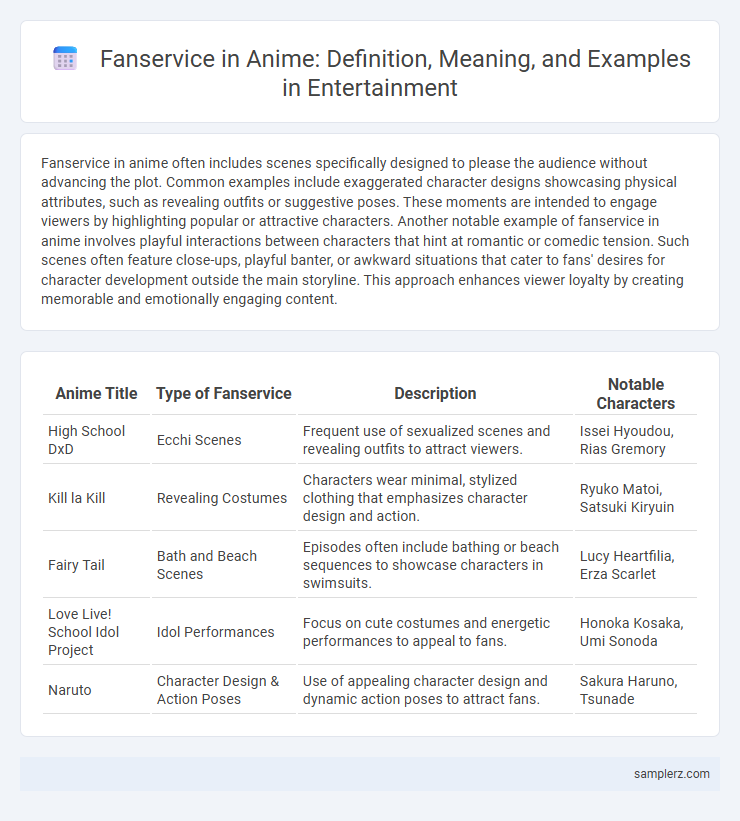Fanservice in anime often includes scenes specifically designed to please the audience without advancing the plot. Common examples include exaggerated character designs showcasing physical attributes, such as revealing outfits or suggestive poses. These moments are intended to engage viewers by highlighting popular or attractive characters. Another notable example of fanservice in anime involves playful interactions between characters that hint at romantic or comedic tension. Such scenes often feature close-ups, playful banter, or awkward situations that cater to fans' desires for character development outside the main storyline. This approach enhances viewer loyalty by creating memorable and emotionally engaging content.
Table of Comparison
| Anime Title | Type of Fanservice | Description | Notable Characters |
|---|---|---|---|
| High School DxD | Ecchi Scenes | Frequent use of sexualized scenes and revealing outfits to attract viewers. | Issei Hyoudou, Rias Gremory |
| Kill la Kill | Revealing Costumes | Characters wear minimal, stylized clothing that emphasizes character design and action. | Ryuko Matoi, Satsuki Kiryuin |
| Fairy Tail | Bath and Beach Scenes | Episodes often include bathing or beach sequences to showcase characters in swimsuits. | Lucy Heartfilia, Erza Scarlet |
| Love Live! School Idol Project | Idol Performances | Focus on cute costumes and energetic performances to appeal to fans. | Honoka Kosaka, Umi Sonoda |
| Naruto | Character Design & Action Poses | Use of appealing character design and dynamic action poses to attract fans. | Sakura Haruno, Tsunade |
Defining Fanservice in Anime
Fanservice in anime refers to elements specifically designed to please the audience, often including attractive character designs, suggestive scenes, or exaggerated physical features. Common examples include revealing outfits, beach episodes, and comedic situations centered on romantic tension or flirtation. These elements enhance viewer engagement by appealing to fan interests and expectations without advancing the plot.
Iconic Bathhouse Scenes
Iconic bathhouse scenes in anime often serve as classic examples of fanservice, showcasing popular characters in relaxed, visually appealing settings that emphasize character design and interaction. These scenes frequently highlight intricate animation details and playful dynamics, enhancing viewer engagement through subtle humor and suggestive imagery. Notable examples include the bathhouse episodes in series like "One Piece," "Inuyasha," and "Dragon Ball Z," where fanservice complements plot development while catering to audience expectations.
Beach Episodes: A Staple of Fanservice
Beach episodes in anime serve as quintessential fanservice by showcasing characters in swimwear, often emphasizing playful interactions and lighthearted scenarios that deviate from the main plot. These episodes highlight visual appeal and character dynamics, increasing viewer engagement through vibrant, sunny settings and casual, sometimes flirtatious, socializing. Fanservice elements such as exaggerated expressions and suggestive poses commonly appear, reinforcing this trope as a beloved, recurring feature in many anime series.
Over-the-Top Transformation Sequences
Over-the-top transformation sequences in anime, such as those seen in "Sailor Moon" and "Cardcaptor Sakura," serve as iconic examples of fanservice by blending elaborate visual effects with character empowerment moments. These sequences often feature vibrant colors, dynamic animations, and signature music, enhancing audience engagement and emotional connection. Their appeal lies in emphasizing character identity while providing visually spectacular content that resonates strongly with dedicated fans.
Strategic Camera Angles and Close-ups
Strategic camera angles and close-ups in anime enhance fanservice by emphasizing character expressions and physical features that appeal to the audience, such as exaggerated eye contact and accentuated body curves. These techniques create a more immersive and intimate viewing experience, often highlighting moments of vulnerability or allure that resonate with fans. Popular series like "Kill la Kill" and "High School DxD" utilize these methods to strategically draw attention to key visual elements, boosting viewer engagement and fan loyalty.
Cross-Dressing and Gender-Bending Moments
Cross-dressing and gender-bending moments in anime, such as in "Ouran High School Host Club" and "Ranma 1/2," serve as popular fanservice elements that challenge traditional gender norms while adding comedic and romantic tension. These scenes often highlight characters wearing clothing or adopting mannerisms of the opposite gender, creating visually engaging and emotionally complex situations that appeal to diverse fanbases. The use of cross-dressing enhances character dynamics and deepens audience investment through playful exploration of identity and attraction.
Cosplay and Outfit Changes
Fanservice in anime often includes elaborate cosplay scenes where characters don iconic outfits that appeal to fans' visual preferences, enhancing viewer engagement through detailed costume design. Frequent outfit changes during episodes highlight character personalities and support narrative shifts, while also catering to aesthetic enjoyment and merchandise potential. These elements create immersive experiences contributing to the overall fanservice appeal in popular anime series.
Meta References and In-Jokes
Meta references and in-jokes in anime fanservice often include subtle nods to iconic scenes, characters, or creator quirks that enrich the viewing experience for dedicated fans. Examples like "Gintama" frequently break the fourth wall, referencing other popular series or anime tropes to create a layered, humorous connection with its audience. Such fanservice enhances engagement by rewarding viewers who recognize and appreciate these insider details, adding depth beyond typical visual fanservice.
Cameos and Surprise Character Appearances
Cameos and surprise character appearances in anime serve as effective fanservice by creating moments of excitement and nostalgia, such as when minor or beloved characters from earlier series unexpectedly show up in new episodes. These brief but impactful appearances often boost viewer engagement and deepen the connection to the franchise, exemplified by crossovers in series like "Naruto" and "One Piece," where familiar faces pop up to energize fans. This technique leverages fan loyalty and curiosity, making episodes memorable while honoring the broader anime universe.
Blatant Shipping and Relationship Teases
Blatant shipping and relationship teases in anime often involve characters engaging in suggestive dialogue and intimate moments that hint at romantic connections without explicit confirmation. Series like "Kaguya-sama: Love Is War" showcase these tactics through exaggerated facial expressions and close physical proximity to heighten viewer anticipation. These scenes capitalize on audience investment in character dynamics, boosting engagement and fan discussions across social media platforms.

example of fanservice in anime Infographic
 samplerz.com
samplerz.com